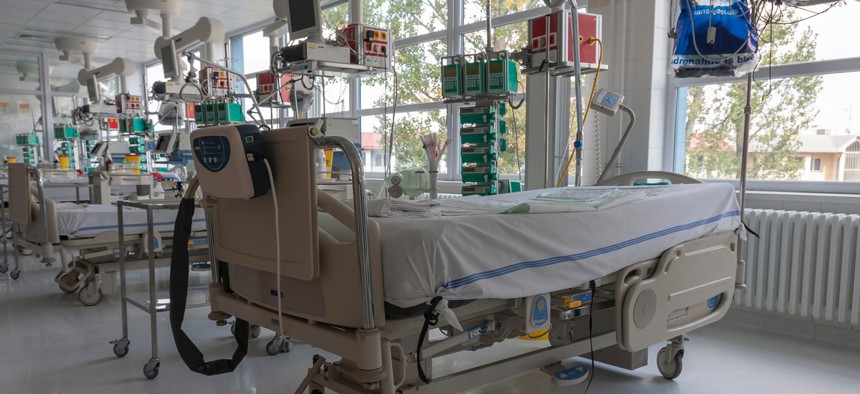Many Areas of the U.S. Face Hospital Bed Shortages

Many hospitals are facing a shortage of beds and ventilators. Shutterstock
Estimates predict that, in a moderate scenario for Covid-19’s spread, 40% of hospital regions would not have enough beds for patients sick with coronavirus.
Though no one knows exactly when it will happen, the coming onslaught of critically-ill patients sick with Covid-19 is expected to far surpass the bed capacity of many hospitals across the country.
New research done by experts at Harvard University explored 12 potential scenarios for the disease—from the modest estimation that 20% of adults will be infected in the next 18 months to the crisis scenario in which 60% of adults will be infected in six months—and mapped them against regional bed capacities across the U.S.
In a moderate scenario, where 40% of adults are infected over the next 12 months, 40% of hospital regions would not be able to accommodate the number of Covid-19 patients who would end up needing care in a hospital, even if all of their beds are empty.
The problem is more pressing in some places than others. The hospital region that includes Olympia, Washington, would need to increase capacity by 189%. Longview, Texas, would need an additional 280% capacity. Some rural areas, by contrast, would face mild shortages, if they face them at all. Sioux Falls, South Dakota, would only need 2% more capacity. A select few places along the Canadian border, like Great Falls, Montana and Grand Forks, North Dakota, require no additional capacity.
Dr. Ashish Jha, director of the Harvard Global Health Institute, said in a statement that the group modeled this information with media outlet ProPublica to supply local officials with the information they need to prepare for their specific scenario. “Crucially, we are providing this information at a local, hospital market specific level. National averages are not very helpful in this context,” Jha said. “It’s irrelevant to a person in Utah how many hospital beds are available in Boston … specific, localized data provides a pathway to understanding what we need to do to get hospitals ready.”
The numbers used in the estimates are based on hospital regions named after large cities in those regions, and while they’re more specific than national numbers, they still can cover large territories. The regions are larger in less-populated areas with fewer hospitals. The Albuquerque region, for example, covers nearly the entire state of New Mexico, meaning that capacity could vary wildly between urban and rural hospitals. When one area is overwhelmed, other hospitals in the region—over even outside it—will have to step up.
An analysis of intensive care bed availability by Kaiser Health News found that more than half of American counties lack those kind of hospital beds, which is a particular risk for older people who have the highest risk of serious illness from Covid-19.
Some medical centers are already preparing for a situation where patients may have to be moved hundreds of miles to hospitals with enough beds and ventilators. In Michigan, Dr. Peter Graham, executive medical director for Physicians Health Plan in Lansing, told Kaiser Health News that hospitals need to prepare for that kind of scenario. “It’s just obvious people are going to need to move,” he said. “If we’re able to find a ventilator bed in Indianapolis, in Chicago or Minneapolis or wherever, it is ‘go, get them there!’”
Governors in some states have already floated the idea of converting evacuated college dormitories into temporary hospitals to house patients who test positive and need treatment for Covid-19. That kind of arrangement would be for patients who are sick, but are not so critical that they require the specialized equipment found in a traditional hospital environment.
Pinar Keskinocak, president of the Institute for Operations Research and the Management Sciences and a professor at Georgia Institute of Technology, said that is the right approach. “I think this is a time for our entire nation to think carefully and creatively about expanding capacity,” she said. “Any existing facility which is not occupied and could be converted with the installation of some equipment and supplies could be helpful as a backup if we run out of space, and I think we will run out of space.”
But Keskinocak said she’s worried about more than just beds—many, if not all, hospitals will likely be short on equipment like ventilators, which have proven to be critical to keeping patients alive when they develop severe complications like pneumonia or acute respiratory distress syndrome and need help breathing. Across the country, both political leaders and hospital officials are already sounding alarms about insufficient availability of personal protective equipment, or PPE, like masks, gloves, and gowns for medical personnel.
California Gov. Gavin Newsom said on Wednesday that hospital leaders are getting desperate. “I heard one case—don’t overpanic on this one, but this gives you a sense—where they were purchasing swim goggles because of concern about face protection,” Newsom said. “Others that were just going out and getting gloves from traditional hardware stores and grocery stores. That’s not acceptable under these circumstances.”
Michael Cox of the Oregon Association of Hospitals and Health Systems said that they worked with Gov. Kate Brown this week to cancel all elective procedures that use PPE, including those at dentists and veterinary clinics. “We’re hoping some things we’re hearing about increased production [of PPE] are true but in the meantime we are taking dramatic steps,” he said. “Our approach is maximum action as early as possible.”
Oregon has been closely following the situation in Washington, where the Seattle region has been a major epicenter of the virus outbreak in the United States. Cox said they’ve been learning from their experience, allowing them to “be on the front foot with our policies.” In the Portland metropolitan area, chief medical officers of major hospitals are forming a regional plan and will operate as one health system with pooled resources and staff, Cox said. “They’ll be in constant communication with one another.”
Some public officials have started to turn to the private sector to help with any shortages hospitals might face. This morning, New York Gov. Andrew Cuomo put out a call on Twitter and during a news conference for PPE, saying the state would buy equipment or offer incentives to companies that figure out how to manufacture it. “We need companies to be creative to supply the crucial gear our healthcare workers need. New York will pay a premium and offer funding,” he wrote.
Car companies with massive manufacturing plants could be a new source of ventilators in the coming weeks. General Motors and Ford said they have both been in contact with government officials to discuss the possibility. "Ford stands ready to help the administration in any way we can, including the possibility of producing ventilators and other equipment," Ford said in a statement. "We have had preliminary discussions with the US government and are looking into the feasibility."
Tesla CEO Elon Musk also said he was open to the idea on Twitter but first wanted to know if any hospitals actually had a proven shortage yet. He got a direct response from New York Mayor Bill de Blasio, who said the city “will need thousands [of ventilators] over the next few weeks.”
Keskinocak said that leaders are correct to be planning ahead. “We have to really think about capacity now,” she said. “Not at the peak when we have to turn people down.”
Emma Coleman is the assistant editor for Route Fifty.
NEXT STORY: Cities Rush to Respond as Homelessness and Coronavirus Collide






